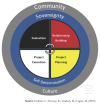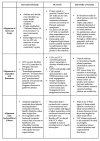Aligning Community-Engaged Research to Context
- PMID: 32069817
- PMCID: PMC7068394
- DOI: 10.3390/ijerph17041187
Aligning Community-Engaged Research to Context
Abstract
Community-engaged research is understood as existing on a continuum from less to more community engagement, defined by participation and decision-making authority. It has been widely assumed that more is better than less engagement. However, we argue that what makes for good community engagement is not simply the extent but the fit or alignment between the intended approach and the various contexts shaping the research projects. This article draws on case studies from three Community Engagement Cores (CECs) of NIEHS-funded Environmental Health Science Core Centers (Harvard University, UC Davis and University of Arizona,) to illustrate the ways in which community engagement approaches have been fit to different contexts and the successes and challenges experienced in each case. We analyze the processes through which the CECs work with researchers and community leaders to develop place-based community engagement approaches and find that different strategies are called for to fit distinct contexts. We find that alignment of the scale and scope of the environmental health issue and related research project, the capacities and resources of the researchers and community leaders, and the influences of the sociopolitical environment are critical for understanding and designing effective and equitable engagement approaches. These cases demonstrate that the types and degrees of alignment in community-engaged research projects are dynamic and evolve over time. Based on this analysis, we recommend that CBPR scholars and practitioners select a range of project planning and management techniques for designing and implementing their collaborative research approaches and both expect and allow for the dynamic and changing nature of alignment.
Keywords: community based participatory research; community–university partnerships; environmental health science; environmental justice.
Conflict of interest statement
The authors declare that they have no conflicts of interest in involved in the production of this article. The funders had no role in the design of the study; in the collection, analyses, or interpretation of data; in the writing of the manuscript, or in the decision to publish the results.
Figures







References
-
- Israel B.A., Parker E.A., Rowe Z., Salvatore A., Minkler M., López J., Halstead S. Community-Based Participatory Research: Lessons Learned from the Centers for Children’s Environmental Health and Disease Prevention Research. Environ. Health Perspect. 2005;113:1463–1471. doi: 10.1289/ehp.7675. - DOI - PMC - PubMed
-
- Andrade K., Cushing L., Wesner A. Science Shops and the U.S. Research University: A Path for Community-Engaged Scholarship and Disruption of the Power Dynamics of Knowledge Production. Educ. Citizsh. Soc. Justice. 2018 doi: 10.1007/978-3-319-62971-1_11. - DOI
-
- Baldwin M. Participatory Action Research. In: Gray M., Midgley J., Webb S.A., editors. The SAGE Handbook of Social Work. 2nd ed. SAGE; London, UK: 2012. pp. 467–481.

